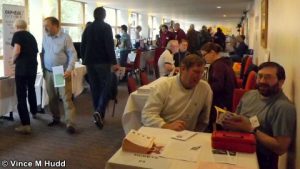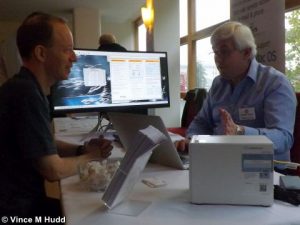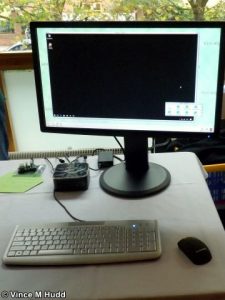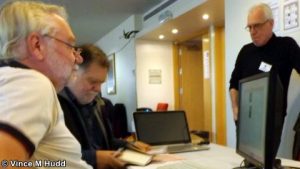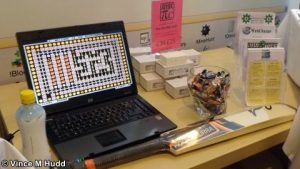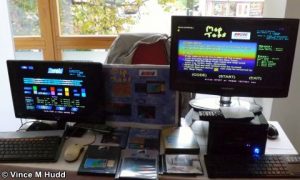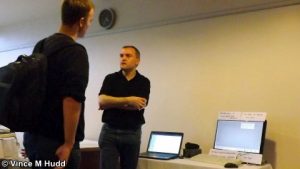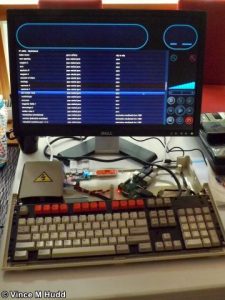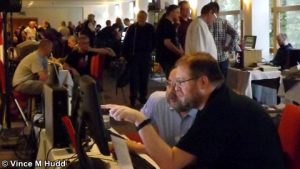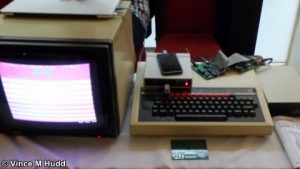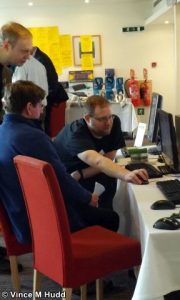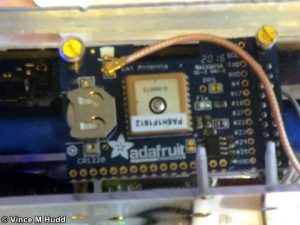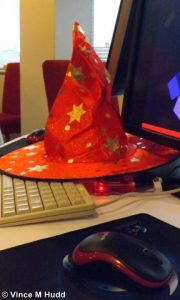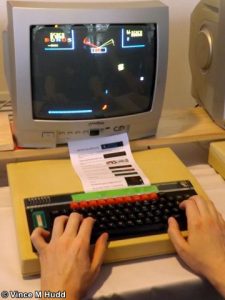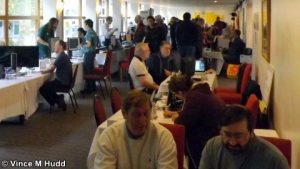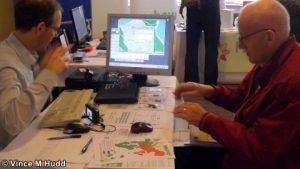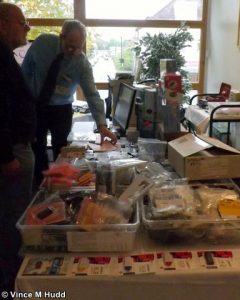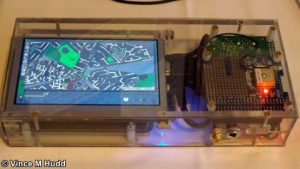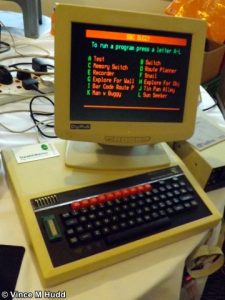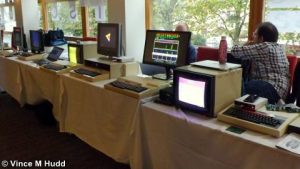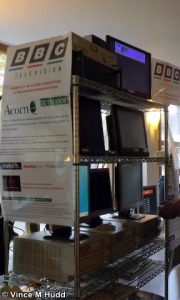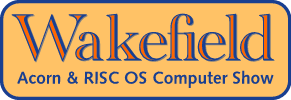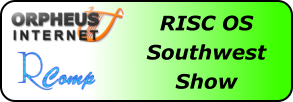Didn’t we have a lovely time the day we went to Bangor London?
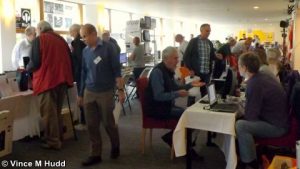
This year’s RISC OS London Show took place on 29th October, and while it wasn’t as large as last year’s event (which I’ll discuss near the end of this report) it was still an enjoyable and worthwhile one. So, without any further preamble, here is a run down of what visitors could have seen, working clockwise from the entrance.
ROUGOL
The first exhibitor was also the user group that organises the event – the RISC OS User Group of London whose stand was the source of much chanting of “Join us… Join us…”
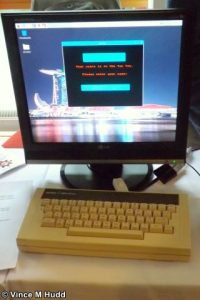
Well, okay, it wasn’t quite like that – but if you’re in or near London, this is definitely the group you want.
ROUGOL holds their meetings regularly, on the third Monday of each month, and more often than not have an interesting speaker – usually someone from within the RISC OS world, talking about their latest product or project, and sometimes someone from the fringes or even beyond. And all of that without charging a fee either for membership entry into meetings – what’s not to like?
Although it wasn’t running RISC OS due to a technical issue with the keyboard, one of the features of the ROUGOL stand this year was an Acorn Electron belonging to Peter Howkins. And, no, the technical issue wasn’t that RISC OS doesn’t fit in a 32KB ROM, and nor was it that RISC OS isn’t compatible with the 6502 processor – while both of these are true, in this case, the heart of the Electron had been pulled out, and was actually housing a Raspberry Pi.
The problem was that Peter hadn’t been able to get RISC OS to read the keyboard – an issue with the interface he had put between that and the Pi.
Archive Magazine
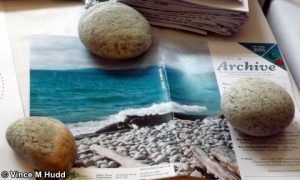
Following a recent trip to his home-country of Canada, Jim Nagel brought a new edition of the Lesser Spotted Archive Magazine to the show.
The cover of the latest issue (24:2) features a photograph of Pebble Beach, which is on the North Shore of Lake Superior, Marathon, Ontario, and Jim had brought along some pebbles from the beach and placed them on the table alongside (and on top of) the magazines.
Inside, the 40 page (including covers) issue was brimming with the usual range of news and interesting features, such as creating an application with AppBasic, using GPS with RISC OS – more on which below – and 3D printing from Topmodel.
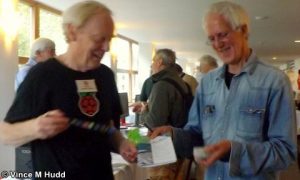
Apparently, the next edition of the Archive magazine CD/DVD – which will add the contents of volume 23 to the mix – is a work in progress, and Jim was taking advance orders for that. Progress is a little slower than ideal, however, because the task was previously undertaken by the late Dave Holden, and some of his tricks and techniques weren’t documented, so there’s a bit of a learning curve to the task.
Orpheus Internet
Moving further up the windowed side of the main hall, Richard Brown was talking up the services of Orpheus Internet.
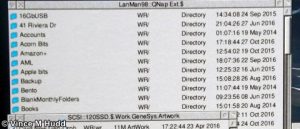
With the usual bowl of sweets on hand to entice people to come and discuss their internet connection requirements, Richard was showing off an impressively fast connection to an Orpheus server directly from the RISC OS desktop on the table at the show. Nice.
Unrelated to the show, an old friend of mine and ex-RISC OS user was in my part of the world a few weeks ago, and we met up for a pint – and during the course of our conversation the subject of Orpheus came up. My friend was very impressed with the way the company (and therefore Richard) had dealt with his mother after learning that his father had passed away some years earlier; a great deal of kindness, respect, and generosity.
As recommendations go, that’s a highly notable one.
RISCOSbits
Andy Marks was next on the RISCOSbits stand, and he had brought along an impressive and innovative range of products with which to tempt visitors.
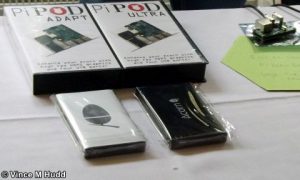
The PiPOD enables the marriage of old (RiscPC) and new (Raspberry Pi) technologies – it is a suitably sized metal plate designed around the ports on the rear of a Raspberry Pi, to allow it to be mounted in a podule slot on a RiscPC, and can be supplied as just the plate, with the user supplying adaptors, cables and screws (which Andy doesn’t recommend), or complete with all the necessary components.
Another neat product was the RiscPOD – a quality hard drive enclosure with an Acorn logo on the outside and a 40GB hard drive on the inside, pre-loaded with a ready-configured copy of either RPCEmu or ArcEm. Or for those who wish to roll their own, just the enclosure and hard drive.
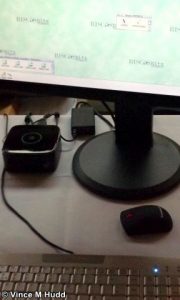
Hinted at before the show was PiSSD, and rather than opting for an instinctive pronunciation, it’s probably best pronounced ‘Pi ess ess dee’ which then reflects what it is, a Raspberry Pi in a ‘luxury’ case, complete with a solid state mSATA hard drive.
The case, Andy explained, was rather expensive so he was only planning to show it off, rather than make it a product – but within a few days of the show (presumably, because enough people had expressed an interest) it was announced as a product.
And then there was GeminX – for which I had hoped to be able to sell baseball bats on my stand, but was unable to obtain a obtain any stock on the day of the show. I did bring along a cricket bat, though.
Why would baseball or cricket bats be appropriate?
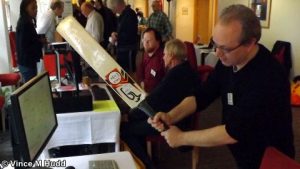
GeminX provides a way to operate a Windows 10 device from the RISC OS desktop. The product aims to be a modern equivalent of the old PC Cards available for RISC OS computers back in Acorn’s day – such as via the second processor slot in RiscPCs.
It takes the form of an Intel Compute Stick, with a modern RISC OS system controlling it using RDP (remote desktop protocol) – and all joking about attacking the devices with bats aside, and despite them running Windows 10, the idea is a neat solution for those who want their primary machine to be running RISC OS, with the occasional need of a PC without it taking up any desk space. That’s pretty much the same thing the PC Cards of old achieved, albeit with a much more modern OS running on the ‘guest’ device.
R-Comp
R-Comp and R-Comp Interactive had, as usual, an extensive range of products – both hardware and software – available to buy.
There was a new version of Fireworkz Pro available on CD, a desktop-environment to use with Elesar’s GoLinux for the Titanium, and an expanded ‘Bundle’ CD for those who purchase (or have purchased) a computer from the company, featuring a range of software such as DeleGate, Messenger Pro, SafeStore, and much more.
On the hardware front, with the value of sterling impersonating the Titanic (thanks a bunch, everybody who voted for the UK to leave the EU), the cost of producing hardware has risen – but R-Comp had enough component stock to build a final batch of ARMSX ARMX6 and TiMachine computers for sale at the show at the old prices.
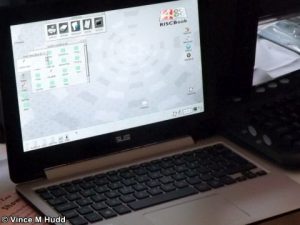
The company also had a new product for sale in the form of the RISCBook Go! Like other machines in the RISCBook range, this is a Windows notebook with VirtualRiscPC installed and configured, ready to go – but bringing a useful form factor to the RISC OS world, the notebook in question is an 11.6″ hybrid one, which can be run as a normal laptop or as a tablet with the screen folded back fully.
Andrew gave one of the day’s theatre presentations, in which he gave a brief run down of the ARMSX ARMX6 and TiMachine, covering their differences and the benefits each offers. He also showed off an example of the RISCBook Go by holding it up for the audience to see – which is a pet hate of mine, but in this case Andrew acknowledged in his talk that it was probably too small for the audience to see.
RiscDJ
London Show regular Michael Emerton was showing off the latest version of RiscDJ – an application designed to collect together information on all the music (or rather audio files – they may not necessarily contain music) found on the computer, presenting the results as a nicely collated library.
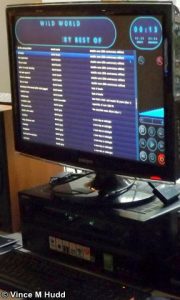
Written in BBC BASIC with Basalt extensions, it is able to play MP3, Ogg Vorbis, FLAC and AC3 audio files, with a rather snazzy looking blue neon user interface.
The only downside for some is that it runs full screen – but that’s because running in the WIMP doesn’t match the way the software was intended to be used. RiscDJ wasn’t written as a music management/library application that can play your music in the background while you work on other things on the computer – instead, the idea is to run it with the computer attached to a large TV, perhaps at a social event, where people wouldn’t be interested in the underlying operating system, and instead want to be able to see what’s playing, and what’s available to play, in a clear and easy to use way.
Similarly, it wouldn’t be out of place in a foyer or waiting area – allowing the public to pick and choose what they hear while waiting.
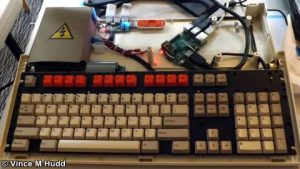
Peter Howkins’ Acorn Electron, found on the ROUGOL stand and mentioned further up, wasn’t the only machine at the show to have its original heart ripped out and be replaced with a Raspberry Pi. There was an Acorn A3000 on the RiscDJ stand that also had a Pi in place of its usual innards. And why not?
Unfortunately, I didn’t get any information about this machine, but given that it could be seen running RiscDJ, it’s reasonable to assume the same keyboard issue found on the Electron wasn’t an issue here. The fact that the A3000 is a newer hardware design than the Electron may or may not be a factor here.
BBCMedia
Alongside Michael, brother Paul (who may or may not be a time traveller) was showing off a range of computers and media from the BBC’s Special Projects. Paul, from Concept Television Studios Ltd, took delivery of the last of this equipment earlier this year, and gave a presentation to ROUGOL on the topic in May.
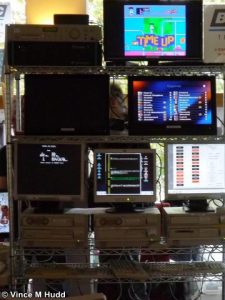
Used in the 1990s for specialised tasks such as producing on-screen graphics for TV shows – for example, titles and scoreboards – Paul has been recovering and archiving some the material, and turning the computers themselves into working demonstration units, and at the show was explaining exactly what that can involve, what he has achieved so far and what still needs to be done.
With most computers (RISC OS or otherwise) being much of a muchness, equipment like this, which was used for particularly interesting things at the time and therefore have a legacy of their very own, are very much worth preserving and showing off – so that they have gone from the BBC to a good home, with someone who understands that, is a very good thing indeed.
Retro Software
For 8-bit enthusiasts, and those in the mood for a little nostalgia – well, sort of – Retro Software was one of the stands to visit.
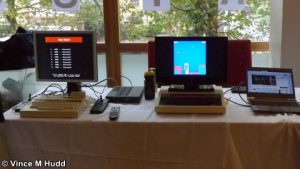
Only ‘sort of’ for those in the mood for nostalgia? That’ll be because there were apparently (unfortunately, I didn’t visit this stand) new and in development games to play on the BBC and Electron computers.
Bitshifters
On the next stand, Bitshifters were showing off such gems as BeebTracker – a program that doesn’t just play back sequenced music, oh no; it goes one better than that, by playing back music ported to the BBC from other systems using a conversion script.
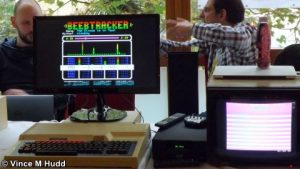
The music is recorded (or to use more appropriate parlance, captured) from the other system in a format called VGM, which stands for Video Game Music, and describes the raw audio data that would be written to the sound chips on the source systems – for example, the Sega Master System. A conversion program then reads the VGM files, and modifies the data for the sound chip used in the BBC Micro.
That file then needs to be compressed so that it can be used in the limited memory of the Beeb – and Bob’s your uncle BeebTracker’s your player.
BeebOPL
The BBC Micro featured a TI SN76489 sound generator chip, featuring three tone channels and one ‘noise’ channel – which could achieve some impressive results (and still can – see Bitshifters, above!) However, time has moved on from those days, and with the rise of the Windows PC came the Ad Lib and Sound Blaster card in the late 1980s and early 1990s, which were a boon for gaming and music.
Being demonstrated on the next stand at the show, BeepOPL brings that same technology to the BBC Micro. This is arguably bringing last week’s technology to last month’s computer hardware, but at the same time, the fact that it’s even possible to do such things with a BBC Micro shows just how impressive Acorn’s old 8-bit hardware really was – and that there is very definitely still life in the old dog!
Charity Stand
As ever, the London Show charity stand was raising money for a very worthy cause, in the form of Combat Stress.
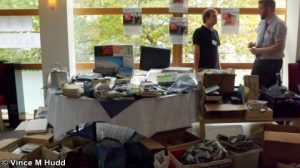
Founded in 1919 (as the Ex-Serviceman’s Welfare Society) Combat Stress treats a range of mental health conditions that can affect veterans, such as PTSD, depression, and anxiety.
This year, the London Show charity stand – helped by all of those who attended the show and either donated goods to be sold, or who purchased something from the stand and thus put money into the coffers – raised £375 for the charity.
3rd Event Technologies
Making noise music, 3rd Event Technologies were demonstrating the latest version of the Archimedes Music Creation System.
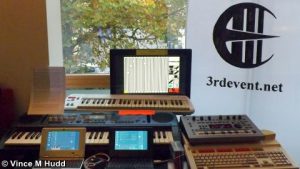
AMCS is a music sequencer that doesn’t just run on RISC OS, but actually sidesteps it, replacing it with its very own operating system. The software was developed to run on an A3000, but has since been ported to a couple of other ARM-based devices. All in all, an impressive piece of work.
AMCOG Games
The show saw the launch of another new game by Tony Bartram, which was being demonstrated and sold on the Amcog Games stand.
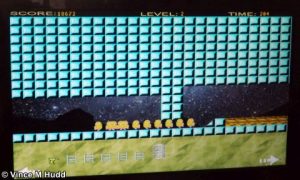
Called Mop Tops, the game takes its inspiration from Lemmings – but with some differences.
In both games, the objective is to manipulate things so that the titular characters can safely navigate their way to the screen’s exit – but while in Lemmings you assign particular tasks and skills to individuals, in Mop Tops, you instead drop the available tools in appropriate locations for the individuals to pick up and use, with some tools being re-usable, and some only able to be used once, and some that can be used by the entire tribe.
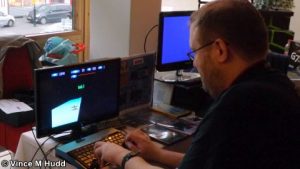
Some of those tools are a little, erm, ‘out there’ – such as positioning a giant fan to blow the Mop Tops safely over a drop. Methinks Tony may have eaten a little too much cheese before going to bed one night, because that must have been one very weird dream he had!
But still – the result is a fun game, and provided people buy it Tony will be able to buy more cheese, and who knows what fun games he’ll produce as a result in future?
CJE Micro’s
The little shop with a lot of stock that is CJE Micro’s occupied the far end of the main hall with – as always – a very wide range of goodies small and large, and all sizes inbetween.

One of the smaller items that proprietor Chris Evans felt worthy of attention was a three button (that’s proper buttons, with not a scroll wheel in sight) optical mouse which he says were previously quite expensive at something like £38.00, but due to a new, lower priced source can now be had for £19.00. I have the same model of mouse myself, though obtained from another source (and, yes, it was rather expensive at the time) and I can definitely recommend it.
At the larger end of the scale, the company of course had Eastwood RapidO Ig and Rapido Ti systems for sale – and falling somewhere between the size of a mouse and the size of a full blown desktop computer, the star of the CJE stand had to be the RapidO Top pi-topRO, which although talked about for a while, is now an official product that is readily available to buy.
On the software front, Photodesk has now been updated to be compatible with all modern systems that currently run RISC OS – which includes the different RGB component order of pixels on Titanium and IGEP-based systems.
And not entirely unrelated to Photodesk, the possible new hardware that was being hinted at was a pressure sensitive graphics pad – the company is evaluating different models, and hopes to be able to supply one for use with RISC OS computers for around the £100 mark, so watch this space.
Chris also gave one of the theatre presentations, in which he once again eschewed the modern technology available to him in favour of holding things up for the audience (and camera) to struggle to see.
Unsurprisingly,The pi-topRO was featured heavily in the talk, with other subjects including the aforementioned mouse, some USB-powered speakers, and more.
And returning to my pet hate, Chris provided a small comedy moment – and a demonstration of why it’s a good idea to use the projector to show slides, including pictures of the things being talked about – when he temporarily lost the ‘pen’ needed for the graphics pad when getting it out of its bag to show the audience.
RPCEmu
Helping solve the problem of using a nice, user friendly operating system on horrible, alien systems, Matthew and Peter Howkins are London Show regulars, with RPCEmu.
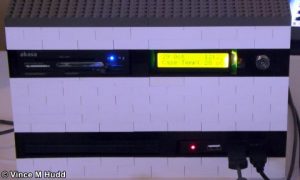
The latest version of the emulator was released in the run up to the show, and addressed a number of issues and, for Windows users, a small change was made to the user interface.
The duo also have a habit of bringing along another pet project for fun, and this year that took the form of a lego-built desktop case for the Raspberry Pi, with a two line LCD display built in, displaying things like the case temperature.
Why?
Just because, okay?
Sine Nomine
Stepping out of the main hall and into the side room, Sine Nomine were showing off the latest versions of all their software – though RiscOSM, which displays maps derived from OpenStreetMap date, was proving to be the headline act.
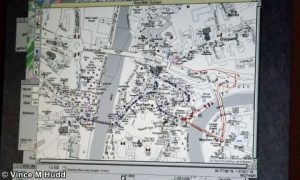
A new feature of the software is the ability to intelligently ‘trace features’ on the map, which allows different types of path or road to be followed when planning/drawing a route, depending on your mode of transport – for example, if you tell it you’re driving it won’t allow the route to follow a footpath.
The software can also import CSV files, which is an improvement over the importation of GPX files in earlier versions. GPX files usually contain a route of some kind, having been recorded by a GPS device – but CSV files could be (for example) exported from a database and, rather than being a route of some kind, contain a list of locations of interesting or related features that can then be displayed as ‘pins’ on the map.
When importing such a file, RiscOSM attempts to recognise key fields in the data, such as postcodes or grid references, which the user can override if necessary, deciding what data to use to find the item on the map, and which data to present as information about it.

And if RiscOSM was Sine Nomine’s headline act, then the headline feature of the headline act was the ability to listen out for GPS data provided to it by software such as Chris Hall’s SatNav. The software has an options to record the route for future reference, and whether or not to follow the signal, scrolling the map as necessary – with the latter being optional because it’s conceivable that in future it might be possible feed in data from other sources, with multiple points being shown on the map.
If you read The Register and have followed their PARIS and LOHAN projects, for example, you will have had the opportunity to see live updates of test flights shown on a map – that’s the sort of thing that could, in theory, be possible to monitor in RiscOSM if the GPS feeds are available.
Much of this was covered in more detail during Matthew’s theatre presentation – although he was unfortunately hampered by the lack of a working internet connection:
Soft Rock Software
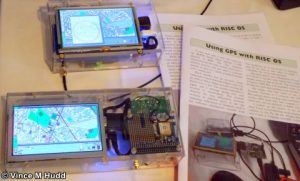
Moving on from Sine Nomine and RiscOSM – though not entirely -the software could also be seen running on the Soft Rock Software stand, on two portable Raspberry Pi Zero-based devices put together by Chris Hall.
Both of these were equipped with a battery to provide power throughout the day, a touch screen, and a GPS ‘HAT’ add-on. Chris’ own software, SatNav, was running to obtain the NMEA sentences fed from the GPS device, process it, and then broadcast the results for other software – in this case RiscOSM, obviously – to act upon.
Also on the stand was the remaining current stock of RiscPiC-mini cases for the Raspberry Pi, allowing RISC OS fans to put their credit card-sized computers in a case designed to look a bit like the iconic RiscPC. With the Titanic pound sterling (thanks again, EU ‘Leave’ voters!), it’s not known when the next stock will be available, nor when it will be possible to do further work on other versions planned for the range – at least without charging more for them.
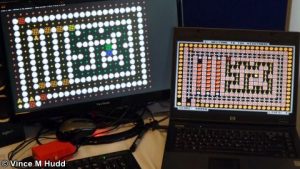
Visitors could also play Soft Rock’s old games, such as Floopy, or see the initial graphics and screen designs for the in-progress rewrite of Escape from Exeria, which will see the number of screens expanded from the original 40 to at least 160, and the game’s monsters made more aggressive than before.
The stand was also home to a skull-shaped bowl of not-skull-shaped (and in fact just plain ordinary) sweets, and a cricket bat for the purpose of smashing up any Windows 10 devices brought along to the show. Sadly, there were no baseball bats available to buy.
RISC OS Open Ltd
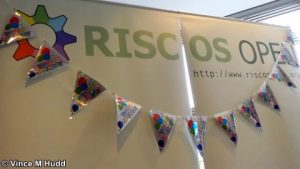
Celebrating ten years, four months and nine days since the official formation of the company on 20th June, 2006, Steve Revill and Ben Avison failed to understand the need for cake on the RISC OS Open Ltd stand – and had instead brought badges for people to buy.
If badges weren’t enough, there was a new version of Nut Pi, updated for the Raspbery Pi 3. For those who have been not paying attention, Nut Pi is a selection of commercial software brought together and sold as a collection for use on the Pi, for a much more reasonable price (considering the price of the board itself) than it would cost if bought individually.
The updated collection includes the latest versions of the DDE from RISC OS Open themselves, SparkFS from David Pilling, Impact from Sine Nomine, and much, much more.
Steve Revill also gave one of the day’s theatre presentations, in which he summed up the year since the last London Show, discussed the updated Nut Pi collection, looked at the bounty scheme and what progress is being made on existing bounties, as well as a possible roadmap for future bounties, and more:
Riscy Robots
There was wizardry afoot on Neil Fazakerley’s Riscy Robots stand. Well, I say wizardry – there were wizard’s hats, which is not quite the same thing.
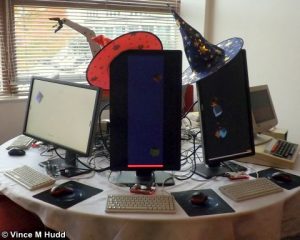
Those hats spent most of the day atop two monitors that were both in portrait mode – i.e. rotated through 90 degrees so that they were tall, rather than wide (and therefore ideal for playing videos recorded by victims of VVS, but that’s another matter). Both were displaying a graphical demo running in RISC OS – showing, therefore, that RISC OS is perfectly able to cope with tall, narrow displays; it’s all in the wrist MDF.
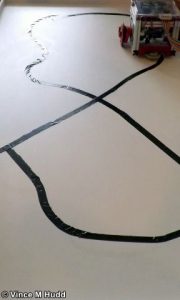
Behind these, Neil had a robot arm to dwarf the one on the end of the RISC OS Open stand, and this year’s special feature (for Neil tends to have something extra on his stand each year) was a roving robot controlled from a Stealthmaster.
What’s a Stealthmaster? It’s a BBC Master computer, housed in an older, standard BBC Microcomputer case – because, apparently, that case is better.
There were a number of pre-set programs available to control the robot, which could be selected by pressing the appropriate letter key on the computer.
Steve Fryatt
Having in the past come dangerously close to infringing on my “I haven’t done anything since the last show” trademark, Steve Fryatt was demonstrating that he really, really doesn’t want a legal headache – he did just have updates to existing stuff available, he also had something new to show off.
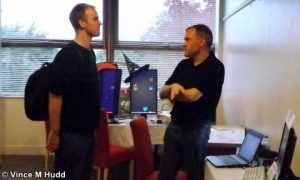
That something took the form of PS2Paper, a utility designed to work along side the Acorn Level 2 PostScript printer driver. The driver demonstrates a surprising lack of knowledge of paper dimensions, instead using the paper size’s name to determine what to pass to the PostScript output, and Steve’s program therefore addresses that, making the system a touch more practical and user friendly to boot.
Tricky Games
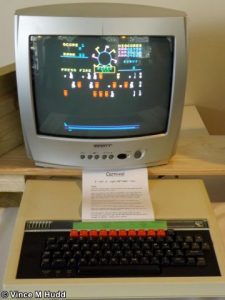
Back in the main hall, fans of 8-bit games were being catered for again, this time by Tricky Games. Richard Broadhurst – the ‘Tricky’ in question – had brought along a selection of old and new games for the BBC Micro.
One such game was Carnivale, and with both the old and new versions available to play. The player’s objective is to shoot the animals moving across the screen – much like a real game found at a fairground, where the animals are tin cut outs moving from side to side on belts – and, through a narrow gap, the flags on a spinning wheel at the top.
According to Richard, the original Acornsoft version was somewhat disappointing and he wanted to improve on it. And why not?
Drag ‘n Drop
The latest issue of on-off-on-off-under-new-management PDF magazine Drag ‘n Drop was published on the day of the show, and Christopher Dewhurst was present with huge piles of the issue for visitors to buy and take away.
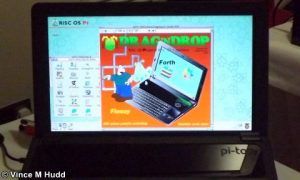
Except he wasn’t because being a PDF magazine, it’s just a digital file – and bits and bytes don’t weigh a thing, even when there are over a million of them!
The latest issue is the first issue of volume 8, and Christopher is keeping up the crazy paving page numbering tradition first spotted by RISCOSitory a couple of issues back, this time by having 44 pages, numbered from 1 to 42, which includes no number for the front cover, two pages numbered 5, no page 38, and two page 39s.
Other features in this issue include several pages of news, some regular columns, and a number of features with ‘type-in’ listings – such as a game, called Floozy, in which the term doesn’t mean what you might at first think: Your goal is to place sections of pipe in the correct place to ensure a water supply flows through it without causing a flood.
ImpressionX
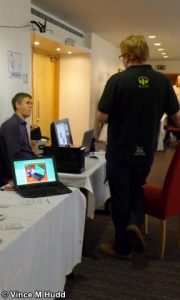
Keith Richard Keefe, was giving people the low down on Impression-X [website still still to come] the in-progress update of Computer Concepts’ popular desktop publishing software, to bring it not only into the slightly wider 32-bit world, but also compatible with the various new pieces of hardware on which RISC OS runs.
Unfortunately, I didn’t speak to Richard this time around, so I don’t know what further progress has been made since Wakefield, at which point there was still an awful lot of work to be done before the software would be usable on modern systems without the support of Aemulor, but good progress was being made.
Organizer
The penultimate stand was home to North One Communications where Martin Avison and Cut-me-own-throat Dibbler Nigel Willmott had the latest version of Organizer , the – no THE – personal information manager for RISC OS, for people to, well, organise their lives.
A new feature of the software – which neatly follows Elesar’s release of CloudFS in September – is the ability to encrypt Organizer’s data, making it safer for storage in a cloud-based location.
Ident Computer
Tom Williamson of Ident Computer was a new exhibitor at the London Show – and at RISC OS shows in general.
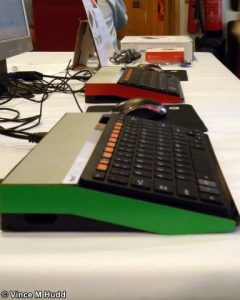
As well as a Raspberry Jam regular, Tom has previously exhibited at the 2015 and 2016 Recursion Computer Science Fair which, although there is a RISC OS contingent present, is not a RISC OS show itself, and he has given talks at recent Midlands and London user group meetings.
The company produces the Micro One computer, a Raspberry Pi-based system in a kit-form case, and as well as display models for visitors to see and play with, a small number were available to purchase.
The kit is available in a range of three trim colours with a fairly obvious theme – red, green, and blue – and when built, it is a similar size and shape to the Acorn Electron, an example of which could be seen directly opposite, where Peter Howkins’ Pi-flavoured Electron could be found.
Tom also gave one of the day’s theatre talk which, due to the available time, was a slightly compressed version of the talk he has previously given at the aforementioned user groups:
So that was the 2016 London Show.
As I mentioned at the start, the show was smaller this year – there are three side rooms running off from the main hall, with one used for the show theatre. Last year, both of the other two rooms were used, but this year just one – this is because there were marginally fewer exhibitors this year than last, so the extra space simply wasn’t needed.
The number of visitors was also down on last year by a small amount, unfortunately, although the show felt (for me, as an exhibitor) just as busy – but a factor in that may have been the extra interest in Chris Halls’ SatNav, being exhibited on my stand.
Although there were fewer visitors, it wasn’t because there were no interesting or exciting products on display this year – Chris’ SatNav was one of several such things: We also saw the pi-topRO on the CJE Micro’s stand, oft discussed but never an official, finished product until now. Then there was the RISCBook Go! from R-Comp, and the Micro One from Ident, and a whole raft of things on the RISCOSbits stand.
So all I can say is that if you didn’t come – and didn’t have a good excuse, like being in a different country at the time – shame on you; it’s not as though the London Show is difficult to get to – if anything, it’s the easiest of the three shows we still have in the UK, with bus stops right outside and a railway station a two minute walk away.
The next two shows lined up are the 2017 Southwest and Wakefield Shows, on 25th February and 22nd April, respectively – I will be at both, and I sincerely hope to see plenty of you at them as well.
And with that, some more pictures. There are a selection on Twitter taken by Matthew Phillips – click on ‘Latest’ at the top to make sure you’re seeing this year’s (until next year, when that advise will be out of date for this year) – and the rest of mine, displaying their usual poor quality, can be found below:
